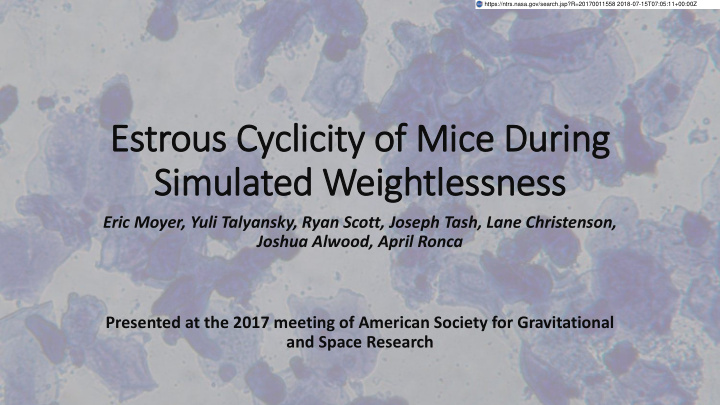



https://ntrs.nasa.gov/search.jsp?R=20170011558 2018-07-15T07:05:11+00:00Z Estrous Cyclicity of Mic ice During Sim imulated Weightlessness Eric Moyer, Yuli Talyansky, Ryan Scott, Joseph Tash, Lane Christenson, Joshua Alwood, April Ronca Presented at the 2017 meeting of American Society for Gravitational and Space Research
Motivation for studying estrous cyclicity in simulated weightlessness • STS-131, STS-133, STS-135 revealed cessation of estrous cycle in female mice (Tash 2012 & Ronca 2014) • Spaceflight leads to loss of corpora lutea and significantly reduced estrogen receptor mRNA levels in the uterus Goals of this study • Assess whether female endocrine Ground Flight signaling biomarkers are altered in Unpublished images from Tash simulated weightlessness via hindlimb unloading model in both reproductive and non-reproductive organs
Experimental Design Normally Loaded Hindlimb Unloaded Vivarium Control Hindlimb Unloading (HU) n=10 n=10 n=10 16 wk C57BL6 female mice Begin HU HU Primary endpoints: 1. Did mice maintain/return to normal estrous cycling? 2. Were there structural changes to reproductive -3 0 12 organs (ovaries, uterus, vaginal wall)? 3 day cage Dissection acclimation
Methods: Daily lavage and Imaging Proestrous Estrous Metestrous Diestrous McLean, A. C., Valenzuela, N., Fai, S., Bennett, S. A. Performing Vaginal Lavage, Crystal Violet Cora, Michelle C., Linda Kooistra, and Greg Travlos. "Vaginal cytology of the laboratory rat Staining, and Vaginal Cytological Evaluation for Mouse Estrous Cycle Staging and mouse: review and criteria for the staging of the estrous cycle using stained vaginal Identification. J. Vis. Exp. (67), e4389, doi:10.3791/4389 (2012). smears." Toxicologic pathology 43.6 (2015): 776-793.
Methods: Cytology Analysis Experiment Landmark Day • Translate qualitative date into an HU Cage Acclimation -3 Begins experiment timeline for each mouse defining Day 0 as start of HU Treatment Begins 0 treatment. Euthanasia/Tissue 11/12 Collection • Graph each animal’s estrous cycle in relation to other experiment landmarks Hypothesis • Hindlimb unloading will cause mice to arrest estrous cyclicity in the diestrous stage
Result: Pair-feeding/Cage effect observed 23 7 VIV VIV Food Consumption (g) 22 NL NL Body Mass (g) 21 5 HU HU 20 19 3 1 0 0 5 10 0 5 10
Result: Differences observed in HU reproductive organs and adrenals
Cytology Results • Average cycle length of vivarium cage control animals was 4.7 days. • In line with reported literature 1,2 • Suggests our technique did not impede normal cycling • Normal cycling did not present in many animals during the acclimation to HU cages, or even throughout remainder of experiment. • Some occurrences of cycling did return to HU cage mice. • Infection-like symptoms resulted in missing data in HU mice. 1. James F. Nelson, Lêda S. Felicio, Patrick K. Randall, Clifford Sims, Caleb E. Finch; A Longitudinal Study of Estrous Cyclicity in Aging C57BL/6J Mice: I. Cycle Frequency, Length and Vaginal Cytology. Biol Reprod 1982; 27 (2): 327-339. doi: 10.1095/biolreprod27.2.327 2. Byers SL, Wiles MV, Dunn SL, Taft RA (2012) Mouse Estrous Cycle Identification Tool and Images. PLoS ONE 7(4): e35538. https://doi.org/10.1371/journal.pone.0035538
Conclusions • Cage effect/Pair Feeding effect present • Validated model for observing estrous stage in VIV control • Longer acclimation period may allow control cage animals to return to normal estrous cyclicity • Longer HU period may allow HU animals to acclimate and return to normal estrous cyclicity
Thanks to those who contributed NASA Ames Research Center Kansas UMC • Joshua Alwood • Lane Christenson • Catherine Choi • Joseph Tash • Parker Dubee • Ayana Kishibuchi • Eric Moyer • Kotaro Okada • Megan Pendleton • April Ronca • Ryan Scott • Pantelis Solomides • Brad Staten • Yuli Talyansky This research was supported by NASA • Nicholas Thomas Space Biology Grant NNX15AB48G
Recommend
More recommend